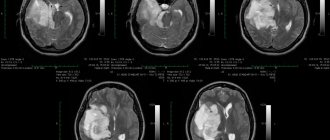Dysfunction of the autonomic nervous system (autonomic dystonia)
Today, vegetative pathology is an important branch of neurology. Dysfunction of the autonomic nervous system or autonomic dystonia (vegetative-vascular dystonia, neurocirculatory dystonia) occurs very often (50% of all neurological disorders) and is manifested by a variety of symptoms in the most bizarre combinations: persistent cardialgia (“heart pain”), arterial “hypertension” or “hypotension”, tachycardias or arrhythmias, prolonged and “incomprehensible” hyperthermia (low-grade fever), difficulty inhaling or shortness of breath with irregular breathing rhythm, nausea and vomiting, sweating, dizziness and various “vegetative paroxysms” (“panic attacks”). Previously, relatively persistent changes in the autonomic nervous system were called “autonomic neurosis.” The leading etiological factors of autonomic dystonia are considered to be negative emotions and nervous tension, and it itself is often considered an early compensatory and adaptive reaction of the vascular system. Persons with constitutional vegetative lability and a family history of this factor are more prone to angiodystonia. Infectious - toxic and allergic influences increase the sensitivity and vulnerability of the autonomic nervous system. Angiodystonia tends to be chronic with remissions and relapses. Moreover, repeated infections, hypothermia and psychotrauma can provoke relapses in this pathology.
In the body, the autonomic nervous system ensures the preservation and maintenance of homeostasis , including heart rate, blood pressure level, blood pH, biochemical parameters, etc. In addition, this section of the nervous system takes an active part in the mobilization of various functional systems of the body to adapt to the external environment.
From the point of view of anatomy and morphology, segmental (peripheral autonomic nerves and plexuses, ganglia, lateral horns of the spinal cord, autonomic nerve nuclei in the brain stem) and suprasegmental sections of the autonomic nervous system are distinguished.
Segmental damage always manifests itself locally (“focal” isolation of prolapse or irritation): Horner’s syndrome (sympathetic fibers), local anhidrosis or depigmentation (lateral horns of the spinal cord), “fixed pulse” (neuropathy in diabetes mellitus), etc. Anatomically suprasegmental parts of the autonomic The nervous system includes: the upper parts of the brain stem, the hypothalamus, the limbic system, and the associative areas of the cerebral cortex. The suprasegmental lesion is characterized by its integrative nature, i.e. coordination of vegetative functions with emotional, motor, hormonal reactions, aimed at the implementation of a holistic act of behavior. Disintegration syndromes manifest themselves as a violation of the coordinated work of vegetative, emotional, motor, endocrine, immune acts: “vegetative crises” when “waiting” for danger or trying to take control of the functional activity of organs. Autonomic dysfunction syndrome can be expressed in three variants: peripheral autonomic failure syndrome, angiotrophoalgic syndrome, psychovegetative syndrome.
Peripheral deficiency syndrome occurs when there is degeneration and atrophy of neurons in the lateral horns, autonomic ganglia, peripheral nerve fibers ("autonomic neuropathy") and other segmental structures. The main symptoms of peripheral autonomic failure: orthostatic hypotension, tachycardia at rest, arterial hypertension in the supine position, hypohidrosis, gastroparesis, impotence, urinary incontinence, constipation, diarrhea, decreased vision at dusk, sleep apnea. There are primary and secondary forms of peripheral autonomic failure. In the primary form, there is chronic, progressive degeneration of autonomic neurons (isolated or combined), found, for example, in parkinsonism and ataxia. , hereditary polyneuropathies (damage to motor and sensory peripheral nerves). Secondary forms of peripheral autonomic failure occur more often against the background of somatic and organic diseases of the central nervous system (spinal cord damage, multiple sclerosis, alcoholic encephalopathy, Korsakoff's syndrome, etc.). Secondary peripheral insufficiency is observed in diabetes mellitus (tachycardia at rest), alcoholism (sweating), amyloidosis, porphyria (gastrointestinal disorders), connective tissue diseases, vitamin B12 deficiency, various intoxications, and even simply in the elderly and senile people.
Angiotrophoalgic syndrome is mainly manifested by local autonomic disorders on the extremities (Raynaud's phenomenon, causalgia) and occurs in three variants: painful, vascular and trophic. Angiotrophalgic syndromes occur in various neurological diseases of the brain and spinal cord: spinal osteochondrosis, tunnel syndromes, polyneuropathy, etc., as well as in connective tissue diseases (scleroderma), circulatory failure, endocrine or gastrointestinal pathology, etc.
Psychovegetative syndrome should be considered the most common manifestation of vegetative dystonia syndrome . Of interest are the principles and algorithms for diagnosing psychovegetative syndrome: exclusion of somatic and neurological (vestibular disorders, fainting, cephalgia, functional neurological disorders: pseudoparesis, ataxia, local paresthesia, etc.) diseases ((determination of their specific gravity), identification of factors determining the “choice organ" ("main complaint"), identification of the "multisystem" nature of autonomic disorders, clarification of the permanent and paroxysmal course, determination of affective, emotional, motivational psychopathological syndromes.
The phenomenology of psychovegetative syndrome (“the channel along which autonomic dysfunction flows”) is determined by: predispositional factor, previous diseases of the organ or system (locus minoris resistense), the vital significance of the organ, observation of similar disorders in people “significant” to the patient, the presence and nature of psychotraumatic factors .
Symptoms of autonomic disorders
Cardiology: rhythm disturbances, heart pain (senestopathy), blood pressure fluctuations
Pulmonology: hypervenilation disorders
Gastroenterology: dyspeptic disorders
Otoneurology: non-systemic dizziness, presyncope
Urology: pollakiuria, cystalgia, etc.
With psychovegetative syndrome, affective (anxiety-depressive spectrum disorders) and motivational disorders (weakness, tiredness, fatigue, decreased appetite, weakened libido, sleep disturbances), as well as complex hypochondriacal syndromes are identified.
Treatment of autonomic dysfunction syndrome requires compliance with the rules of general hygiene, the correct rhythm of life, sanitation and foci of chronic infection. The main medications used to treat the syndrome are tranquilizers (short period and systematic use to eliminate dependence) and antidepressants from the group of selective serotonin reuptake inhibitors (SSRIs). For moderately severe psychovegetative syndrome, herbal medicine is used (for the hypersthenic version of the syndrome - preparations of valerian, hawthorn, motherwort, for hyposthenic - eleutherococcus, zamanikha, gin - shen). The choice of vegetotropic drugs is determined by the symptoms of changes in the tone of the autonomic nervous system: sympathicotonia, vagotonia or mixed (normoparasympathicotonia against the background of hyposympathicotonia) forms. In order to more accurately determine the tone of parts of the autonomic nervous system, our clinic uses neurophysiological techniques (sympathetic evoked potentials and cardiointervalmetry). For systemic hypertension, medications are prescribed that inhibit central sympathetic activation (clofelline), alpha and beta adrenergic blockers (anaprillin). In order to regulate regional vascular tone, no-shpa, papaverine, dibazol, calcium antagonists, and alpha blockers are used. To improve microcirculation and the rheological state of the blood, aminophylline, trental, acetylsalicylic acid, dipyridamole (chimes) are prescribed. For mixed forms of autonomic dysfunction syndrome, beletaminal, belloid, and bellaspon are used. They also use agents that improve metabolic processes: aminalon, piracitam, encephabol, vitamins. Non-medicinal means include electrosleep, acupuncture, medicinal electrophoresis, darsonvalization, hydrotherapy (coniferous, oxygen, radon baths). Also recommended are cognitive behavioral and hypnosuggestive therapy, breathing exercises (inhalation: exhalation = 1:2) with a transition to diaphragmatic breathing, breathing into a “plastic bag”, and if signs of tetany appear, calcium and magnesium supplements.
Why does the disorder develop?
Somatoform disorder is a disease of a psychological nature in which the symptoms of damage to internal organs are functional, not organic.
Such dysfunction is detected in 0.5% of the world's population, and it affects mainly women. The reason lies, first of all, in the psychological state of a person.
The first group of factors influencing the occurrence of the syndrome is heredity and character traits. For example, people with asthenoneurotic and hysterical types of character are more likely to develop it. They are characterized by hypersensitivity, timid or demonstrative behavior. Such people are characterized by rapid nervous exhaustion; as a rule, they are pessimistic.
The second group is psychogenic traumatic external influences. These include acute stress factors, when a powerful psychological blow at once leads to a disorder of nervous activity. This could be the loss of a loved one, a decrease in social status, or a situation of severe fear.
Chronic stress occurs as a result of systematic mental and physical overstrain, lack of positive emotions, unmet needs and excessive demands on oneself.
It is worth noting that somatoform disorder very often develops in people who are emotionally stingy, hide their feelings, and do not know how to express them. And since emotions need a way out in any case, they find it in this unique way. A similar state can accompany members of religious families, where an atmosphere of strict morality reigns.
Other factors that provoke the disorder include complicated pregnancy, trauma, infections, and some somatic diseases.
Clinical manifestations
Recurrent somatic complaints usually begin before age 30; Most patients have multiple physical symptoms, but some have only one major symptom, usually pain. Symptoms vary in severity, but they persist and long-term remission is rare. Symptoms or excessive concern about them cause serious discomfort or interfere with the patient's daily life. In some cases, overt depression may develop.
When a psychosomatic disorder accompanies a physical illness, patients become excessively anxious about the consequences of this illness; for example, patients who have fully recovered physically from an uncomplicated myocardial infarction may continue to act sick or constantly fear another infarction.
Whether the symptoms are related to a physical illness or not, patients become overly anxious about these symptoms and their potentially catastrophic consequences, and can be very difficult to reassure. Attempts to reassure are often perceived as the doctor not taking the symptoms seriously.
Fears about one's health often take a central place in the patient's life, and sometimes begin to play an all-consuming role. Patients are very concerned about their health and are often unusually sensitive to the side effects of medications.
This disorder can affect any part of the body, and the symptoms and prevalence of the disorder vary across cultures.
Regardless of presentation, the essence of a psychosomatic disorder is the patient's disproportionately intense or maladaptive thoughts, feelings, or behaviors in response to symptoms.
Patients may become dependent on others for help, emotional support, and may become angry when their needs are not met. They may also threaten or attempt suicide. Patients are often dissatisfied with the quality of medical care, they usually switch from one doctor to another or see several doctors at once.
The intensity and persistence of symptoms may reflect their strong need for care. Symptoms enable patients to shirk their responsibilities, but also reduce quality of life and act as a punishment, causing feelings of inferiority and guilt.
Diagnostics
- Clinical criteria
Symptoms must cause discomfort or interfere with daily life for more than 6 months and be associated with at least one of the following:
- Disproportionately intense and persistent thoughts about the severity of symptoms
- Persistent, severe anxiety about one's health or symptoms
- Excessive amount of time and energy spent worrying about symptoms or health
At the first appointment, doctors take a detailed and extensive history (sometimes in consultation with family members) and conduct a thorough examination and often tests to determine whether a medical condition is causing the patient's poor condition. Since patients with somatoform disorders may develop concomitant somatic diseases, if there is a significant change in symptoms or the appearance of objective signs, it is necessary to prescribe appropriate diagnostic procedures. However, if a somatoform disorder has been explicitly ruled out or a mild disorder has been identified and treated, clinicians should avoid repeating tests; Patients are rarely reassured by negative test results and may interpret their continuation as confirmation that the physician is not confident of a favorable diagnosis.
Anxiety disorder has similar presentations, except that physical symptoms are absent or minimal. Psychosomatic disorder is distinguished from generalized anxiety disorder, conversion disorder, and major depression by the predominance, number, and persistence of somatic symptoms and accompanying disproportionately intense thoughts, feelings, and behaviors.
Treatment
- Cognitive behavioral therapy
Even those patients who have established a trusting relationship with their attending physician should be referred to a psychiatrist for consultation. Pharmacological treatment of comorbid psychiatric disorders (eg, depression) may help; however, psychotherapy, especially cognitive behavioral therapy, is needed first.
Patients also benefit from having a positive relationship with their primary care physician, who coordinates care, suggests ways to relieve symptoms, monitors them regularly, and protects them from unnecessary tests and procedures.
Diagnostics
- Clinical assessment
The diagnosis of an anxiety disorder is based on criteria from the Diagnostic and Statistical Manual of Mental Disorders, 5th edition (DSM-5), including the following:
- The patient is concerned about the fear of having a serious illness or the possibility of getting one.
- Patients have no or minimal physical symptoms.
- The patient is extremely concerned about his health and easily becomes worried about personal health problems.
- The patient constantly checks the health status or inadequately avoids following doctor's orders and hospitals.
- The patient has been consumed by the disease for ≥ 6 months, although specific concerns about the disease may change during this period of time.
- The symptoms are not consistent with those of depression or another mental disorder.
Patients who have severe physical symptoms and who are primarily concerned about the symptoms themselves are diagnosed with a psychosomatic disorder.








